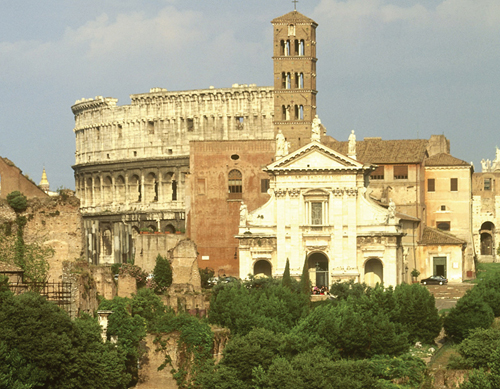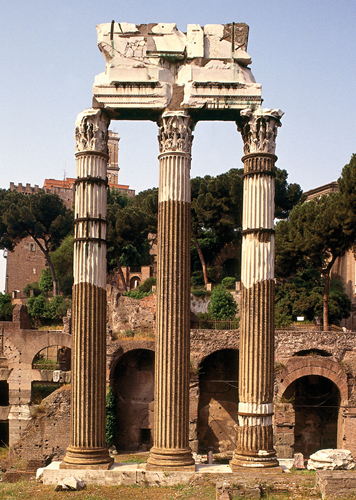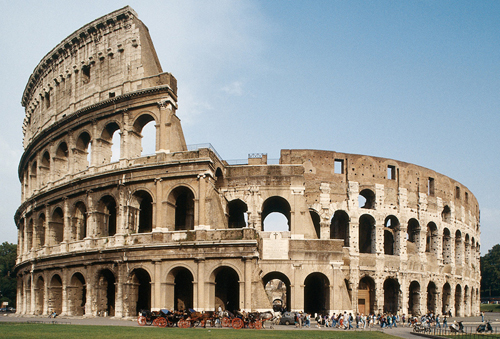Ancient Sights
Roman Forum
In the centre of the Forum stands a humble ruined structure where fresh flowers are placed year-round. This is the foundation of the Temple to Julius Caesar, built by Augustus in the 1st century BC. The flowers indicate the exact spot of Caesar’s cremation (see Roman Forum).
Roman Forum and Colosseum
Pantheon
Originally worshippers approached this temple to all the gods by a steep staircase, but the street level has risen since the 2nd century. The present temple was built by Hadrian, after the 1st-century BC temple burned down (see The Pantheon).

Imperial Fora
The largest temple and one of the most commanding of this imposing zone was the 2nd-century AD Temple of Venus and Rome, its columns standing high on the hill between the Forum and the Colosseum. Its back-to-back design was Hadrian’s, and when the great architect Apollodorus criticized it, Hadrian had him put to death (see The Colosseum and Imperial Fora).

Colosseum
The backbreaking labour to build the greatest of amphitheatres was carried out by a horde of Jewish slaves, brought here following the suppression of their revolt in Judaea. The structure has been the archetype for the world’s sports stadiums ever since (see Colosseum).
Colosseum
Palatine Hill
Most European languages derive their word for palace from the name of this hill. All important in the history of early Rome, first as its birthplace, then as the home of its leaders’ opulent homes, it now serves as a bucolic setting for a romantic stroll (see Palatine Hill Features).
Palatine fresco
Domus Augustana, Palatine Hill
Baths of Diocletian
A large section of this huge 3rd-century AD complex now houses an excellent archaeological museum, including a marble sculpture of Mithras that still retains its gold leaf and paint. A vast Michelangelo cloister is decorated with ancient statuary (see Santa Maria degli Angeli).

Column of Marcus Aurelius
A 2nd-century AD commemoration of conquests along the Danube, this colossus stands 30 m (100 ft) high and is composed of 28 marble drums. The 20 spiral reliefs realistically chronicle scenes from two wars. A statue of the emperor and his wife once stood on top of the column, but it was replaced by one of St Paul in 1589 (see Column of Marcus Aurelius).

Nero’s Golden House
When the rooms of the mad emperor’s house were discovered in the late 1400s, everyone thought they’d found mysterious grottoes. Consequently, the style of wall painting found here became known as “grotesque” and was much imitated by Renaissance artists, including Raphael (see Nero’s Golden House).
Nero’s Golden House
Largo di Torre Argentina
Discovered in the 1920s, four Republican temples stand out distinctly, with the columns of a portico at the north end. The drainage gutters of an Imperial public latrine are behind one temple, and behind others stands the tufa-block platform of the Curia of the Theatre of Pompey. Caesar was killed here on 15 March 44 BC (see Largo di Torre Argentina).

Theatre of Marcellus
The theatre was inaugurated by Augustus in 23 BC and dedicated to his nephew and son-in-law Marcellus, who had just died, aged 19. Not much remains of the once huge structure, which held up to 20,000 people. In later ages, what was left of it was used as support for medieval and Renaissance fortresses and palaces (see Theatre of Marcellus).
Top 10 Roman Emperors
Augustus
The first and most brilliant emperor (31 BC–AD 14) brought a reign of peace after 17 years of civil war.
Nero
The most notorious for his excesses, Nero (54–68) fancied himself a great singer and showman. He eventually committed suicide.
Vespasian
This emperor (69–79) ended civil war and the Jewish revolt, and started construction of the Colosseum.
Trajan
One of the most just rulers and successful generals, Trajan (98–117) pushed the Empire to its furthest reaches.
Hadrian
A great builder and traveller, Hadrian (117–38) revived Greek ideals, including the fashion of growing a beard.
Marcus Aurelius
The closest Rome came to having a philosopher-king of the Platonic ideal (161–80).
Septimius Severus
Brought order after civil war, promoted cultural life and left an important architectural legacy (193–211).
Diocletian
Diocletian (284–305) set up a governing system of multiple emperors. A virulent persecutor of the Christians.
Constantine
Constantine (306–37) established Christianity as the state religion and moved the capital to Constantinople.
Romulus Augustulus
The last of the emperors (475–6), deposed by the German warrior Odoacer.
